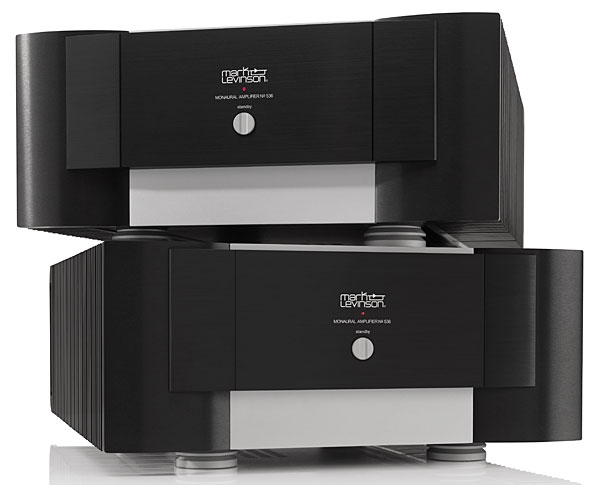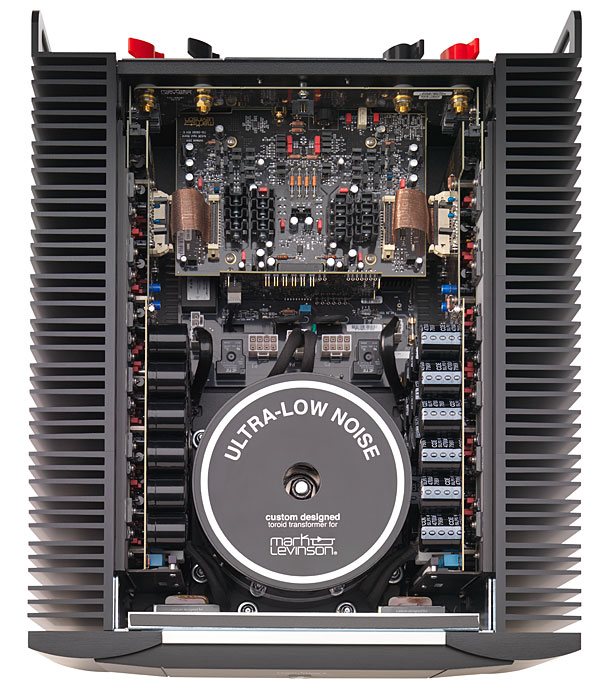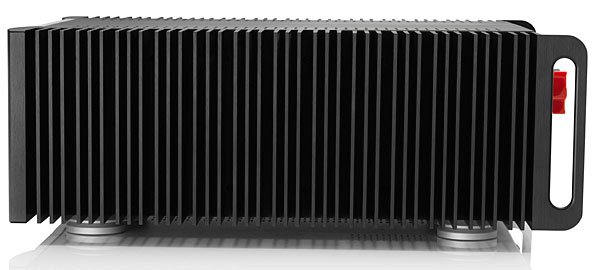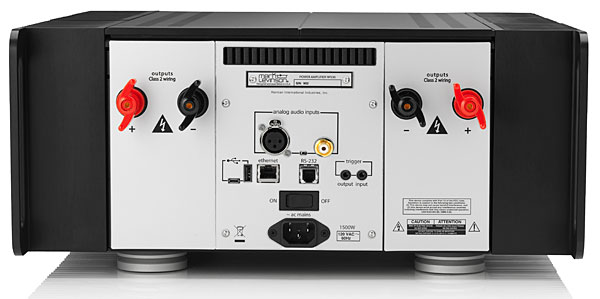| Columns Retired Columns & Blogs |
Excellent review! LG.
Beautiful pics as well.

Paliwal spoke with pride of the facility's output of six new Mark Levinson models in the past 24 months, and pointed with pleasure at the No.536 monoblock amplifier. I smiled: I was already scheduled to review it.
The Monoblock Legacy
The No.536's design fits into a solid tradition of Mark Levinson monoblocks that began in about 1977 with the ML-2, a 25W, class-A amplifier weighing 80 lbs and costing $6490/pair, and that established the design pattern for subsequent ML monoblocks: big, heavy, voltage stable regardless of load, delivering high amounts of current—and expensive. After Madrigal bought Mark Levinson, in 1984, ML produced bigger, more powerful, more costly monoblocks, including the 100W No.20.6 and the 150W No.33H. In 2008, the Harman Specialty Group, which had purchased Mark Levinson from Madrigal, upped the ante with the No.53, a 500W monoblock with a pulse-width-modulated output stage. Paliwal had asked the ECOE to design a "middle-tier" monoblock at half the No.53's list price of $50,000/pair. The result is the class-AB No.536, at $30,000/pair.
Circuit Design
According to Todd Eichenbaum, the No.536's design is new from the ground up. Its signal paths are fully discrete and fully differential, and it has a mirror-imaged circuit topology with high bias current. The No.536's voltage and driver stages are based on the gain stage of the No.585 integrated amplifier. The No.536's output stage is biased to operate in class-A up to 3W.

The No.536's overall gain structure was designed to have linear open-loop performance before negative feedback is applied. This was accomplished by meticulously setting the open-loop gain and bandwidth of the output circuit using precision resistors and capacitors. Once that was achieved, additional resistors were used to add the feedback network. Eichenbaum tuned this design to exhibit no latching, ringing, or oscillating when the No.536 is driven into hard clipping, nor does it round off the waveform. The waveform does exhibit the usual flat top when clipped, but is otherwise clean. Harman specifies the No.536 as outputting 400W into 8 ohms or 800W into 4 ohms, and remaining stable into 2 ohms.
Harman calls the No.536's design Pure Path, an umbrella term used across the Mark Levinson product line—including in the No.526 preamplifier—indicating a direct-coupled signal path, voltage gain and drive stages that use folded cascode circuits and operate in class-A, and the use of minimal feedback and high bias-current settings in the output stage. The folded cascode circuits—built with junction field-effect transistors (JFETs) and bipolar junction transistors (BJTs)—are included to achieve high gain, low noise, wide bandwidth, and excellent linearity.
Construction
Todd Eichenbaum had walked me through the No.536's layout at the 2017 Consumer Electronics Show. Its case of extruded 6063-T5 (aircraft-grade) aluminum measures 17.25" wide by 7.65" high (with feet attached) by 21" deep; openings in the bottom and top plates vent heat and make internal cooling fans unnecessary. The output-stage circuits are mounted on the inner surfaces of the heatsinks. The component quality is tops, and the bulletproof build quality should last a century. Like all Mark Levinson gear, the 100lb No.536 is made in the US.
Eichenbaum removed the No.536's top plate and pointed out that the rectifiers and filter capacitors are directly attached to the output-stage subassemblies, to make the electrical connections short and direct. Second, each of the two output stages handles both inverting and non-inverting signals, which allows each stage to draw current evenly and simultaneously from both the positive and negative supply rails, to maximize the amount of power available to the amplifier.
Although each No.536 drives only one channel, it uses two fully differential, class-AB, 400W output stages in a bridged configuration to bolster its current output. This helps the amplifier remain stable into loads of 2 ohms. Each output stage has 12 discrete TO-264 bipolar power transistors (each rated at 15A, 260V, 200W), and 12 discrete TO-220 bipolar driver transistors.

Each of the No.536's two high-current power supplies contains eight discrete, high-speed TO-220 Schottky rectifiers and 18 paralleled filter capacitors. Including both power supplies, the total storage capacitance of the No.536's 36 filter capacitors is 169,200µF. Just behind the front panel is a single, low-noise, 1800VA toroidal power transformer with separate secondary windings for each output stage.
The No.536 includes the protection design described in my review of the Mark Levinson No.585 integrated amplifier in December 2015, scaled up for the No.536's greater voltages and current handling. It uses redundant pathways—ie, direct connections to the amplifier circuitry itself, as well as to the microprocessor, which monitors the amplifier's operation for ultimate reliability under all conditions. To protect the amplifier and loudspeaker attached to it, the No.536 continuously monitors the heatsink temperature (as a fail-safe, there's also a second temperature sensor on each heatsink), internal operating temperature, power-supply rail voltage, the output current relative to the output-transistor operating voltage, the output voltage, and the output DC level. The No.536 is prevented from overheating by thermal switches inside the power-transformer housing. Recoverable faults—ie, faults that do not indicate amplifier damage—include overheating, incorrect AC input, DC detected at the input, and short circuits across the speaker terminals.
External Features and Controls
The No.536 has Mark Levinson's usual black case with multiple heatsink fins running along each side, and its silver-and-black faceplate trim is reminiscent of my ca-1999 No.334 stereo amplifier. The front panel has only a single button; this toggles the amplifier between On and Standby when the rear-panel Power switch is turned on. Above this is an LED that indicates the operating status: steady red when the amplifier is fully turned on, flashing red while the amplifier is in Standby, steady blue as the amplifier starts up from a reset, and flashing blue while an update is being installed. This same LED also indicates fault conditions: When it continuously flashes white, the No.536 has entered into Safe Protection Mode because of a recoverable fault that can either correct itself (amplifier temperature over safe limit) or be fixed by the owner (speaker terminals shorted together). If it glows a steady white, the fault is nonrecoverable: an output transistor is damaged, or DC is detected at the output (but not at the input); the No.536 will not restart until it is serviced by a Mark Levinson technician.

On the rear panel is the main power switch. Just above sits a row of control and connectivity inputs, including: USB-A, for upgrading the firmware; USB-micro, for accessing the internal webpage; RS-232, for connection to a computer with a serial port; jacks for trigger inputs and outputs; and an RJ-45 connector for an Ethernet link. Single RCA and XLR input connectors are next, flanking a small toggle switch that selects between them. At the top is a row of four speaker terminals with Hurricane binding posts.

Excellent review! LG.
Beautiful pics as well.

Thanks for the review Larry. I have found that these amplifiers are incredibly musical and revealing. Whether classical, vocal, or classic rock, they reveal all that is present in the recorded music. I noted a marked improvement of sound in my system when I introduced these in replacement of an ATI Sgnature 6007. Further refinement was achieved with the inclusion of the matching No. 523 preamplifier. Finally, they control my B&W 800 D2's with ease and finesse. I can't say enough about the pleasing sound of this combination.

you do know who makes the amps FOR mark levinson,,,,,right?

...who makes the amps?

...that wouldn't deter me. Given the small quantities to be sold, it wouldn't make much sense to setup their own production. ATI has a very good reputation, builds a lot of product, and has ultra high end experience with its ownership of Theta. It also allows ML to put "Made in USA" on the product. Somehow I doubt "Made in China" or "Made in Mexico" would go over very well. But it's a fact that the majority of Harman brands now build their products outside the US.

...who makes the amps?
To the best of our knowledge, the current generation of Mark Levinson-branded products is manufactured by Mack Technologies, in Westford, MA: http://www.macktech.com/.
John Atkinson
Editor, Stereophile

googoogjoob - some Levinson amps are made by ATI - that's been known for years. But not all ML amps are made by ATI, some amps, including the No. 536, are designed at "Mark Levinson's new facility in Shelton, Connecticut, where all listening tests and QC checks are also performed. Manufacturing is done at Mack Technologies, in Westford, Massachusetts." This is a quote of Mr. Greenhill's as made in Stereophile and on this web site as part of his review of the ML 585. I'm disappointed you missed that detail given it's importance and relativity to your failed inference.

Has anyone asked Mark, himself, what he thinks of the Mark Levinson Amplifiers?
Nelson Pass has plenty to say about the stuff with his name on it, as does B.H.King about that New PS Audio stuff.
Tony in Michigan
ps. I have plenty to say about everything with my name on it as does our JA, for gods sake

...Levinson give a tinker's damn about these amplifiers? He sold his namesake and his ownership of the company he founded many, many years ago and hasn't looked back since. Mark Levinson (the company) has undergone bankruptcy, numerous sales and acquisitions, finally landing in the Harman fold back in 1990. If he didn't like the amplifier, what then? He'd simply be told to go pound sand by the powers that be at Harman. Of course Nelson Pass has plenty to say about his amplifiers, because...well...he actually designed them, and he still owns a majority financial stake in the company known as Pass Labs.

In response to your comments, I went to Google and looked up a few videos of M.Levinson to discover his involvement in Audio today.
Geez, Mark Levinson is competing with his own Company Name, betcha that's a rarity.
Anyway, Hertz Co. seem to have the same Luxury Ideal that Harmon is doing with the Levinson Branding.
Levinson himself seems a capable salesman, his products seem aimed at the Affluent person wanting to be involved with music reproduction at a rather intimate level. ( Hertz stuff seems "tweaky" )
Hertz only offer the "Best" level, no good or better. Priced at $120,000 for the whole darn thing: Speakers, amps, pre-amp/DAC. So, it's a fully Active System capable of playing at 125db.
Nice looking stuff. I could own it but I'd be more likely to buy a Meridian System.
Well, so much for Mark Levinson.
Tony in Michigan
ps. I once considered the Levinson product line for my Retail Shop. None of us liked the stuff so we declined but did accept the Koetsu stuff. It was from Madrigal ( I think ) c.1985ish

As I understand the court rulings between Madrigal and Mr. Levinson, Mark Levinson (the person) is barred from commenting on Mark Levinson (the brand) by legal restraints.

....use ordinary household, 15amp, shared-power for a $30k amp? In your review you mentioned the Torus AVR TOT power conditioner blew its fuse when the 536 maintained a steady 16A draw. Your investment in gear is deserving of the power its demands.
For 12 years I plugged my 336 into its own 15A socket thinking it had what it needed. The rest of my gear had their own 15A lines as well - but all those lines were ultimately shared. It bugged me to the point where one day I got a few hospital grade 20A receptacles and installed 3 separate 20A lines in to my music room. The difference at first, was incredible. It felt like I released a bull into the street where everyone runs for cover. The midrange was so in my face, I had to turn down the volume down a bit and continue my assessment. The sound stage was wider and deeper and the presentation just effortless - less congestion - although I never knew it was congested before. Remember I'm dealing with an older amp by then and its crappy Phillips caps that were replaced 2x under warranty.
Eventually I began to hear more subtle detail, the white against the black if you will, deeper base that had more slam and control and it was tighter. The highs however, were not as warm as I had hoped and some music left me adrift. **My 32 had it's own line and my 360S/37 shared one line (3 total lines).** Surge protected at the box.
I had read here and there in forums that big wall power is what an amp needs, especially class A like your amazing ML2's. I can't believe I'd never done it before. My 336 is due to be recapped. I can't wait to hear it while its running through Cornell Dubilier's. I also wonder what a dedicated 30A line would sound like?
I would be interested to read what a follow up review would find if you plugged those amazing 536 mono blocks into 2 separate 20A lines. Thanks for a thorough review!
PS: **The installation of the 20A lines was a lot cheaper than a big dollar power conditioner. The $20 receptacles were also cryo treated.